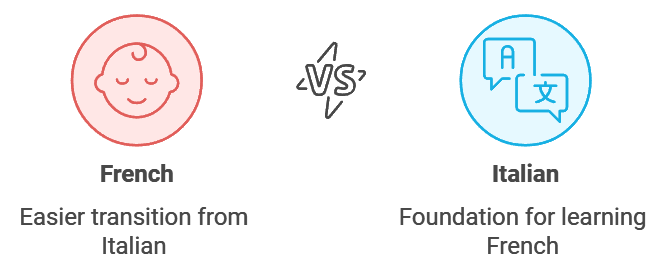Is It Easy to Learn French After Italian?
Learning French after Italian is notably easier compared to starting from scratch, thanks to their shared Romance language roots. If you already speak Italian, you can expect to reach conversational French proficiency in about 3-6 months of dedicated study, roughly half the time it would take an English speaker.
Key Takeaways
- French and Italian share 89% lexical similarity, making vocabulary acquisition faster
- Expect to reach B1 level in French within 3-6 months if you’re fluent in Italian
- Focus on pronunciation differences and false friends to avoid common pitfalls
- Modern learning tools specifically designed for Italian speakers can accelerate progress
- Professional benefits include increased job opportunities in Europe and North America
The Romance Language Connection
The close relationship between French and Italian creates a natural learning bridge. Think of it like knowing how to play the guitar and learning the ukulele – the basic principles are the same, but there are unique elements to master.
Language Similarity Comparison
| Feature | Similarity Level | Examples |
|---|---|---|
| Vocabulary | High (89%) | Italian ‘famiglia’ → French ‘famille’ |
| Grammar Structure | Medium-High | Similar verb conjugations |
| Pronunciation | Medium-Low | Different sound systems |
| Written Form | High | Shared alphabet and patterns |
Learning Timeline Expectations
Your journey from Italian to French fluency depends on several factors:
Fast Track (3-4 months)
- Daily immersion practice
- Previous language learning experience
- Regular native speaker interaction
- Structured study plan
Standard Track (6-8 months)
- Weekly structured lessons
- Regular self-study
- Occasional practice with natives
- Balanced approach

Modern Learning Strategies
Today’s technology offers unique advantages that weren’t available to previous language learners. Here’s how to make the most of them:
Digital Tools for Success
- AI-powered apps that recognize Italian accent patterns
- Virtual reality immersion environments
- Language exchange platforms connecting French and Italian speakers
- Adaptive learning systems that focus on your weak points
Cultural Integration Methods
Want to make your learning more effective? Try these proven approaches:
- Watch French movies with Italian subtitles
- Join online communities of Italian speakers learning French
- Follow French-Italian bilingual content creators
- Participate in cultural exchange programs
Professional Advantages
The combination of French and Italian opens doors to unique career opportunities, especially in:
- European Union institutions
- International business
- Tourism and hospitality
- Translation and interpretation
- Cultural mediation
Certification Pathways
| Level | Certification | Timeline | Professional Value |
|---|---|---|---|
| Basic | DELF A1-A2 | 2-3 months | Entry-level positions |
| Intermediate | DELF B1-B2 | 4-6 months | Professional roles |
| Advanced | DALF C1-C2 | 8-12 months | Expert positions |
Common Challenges and Solutions
Pronunciation Differences
Italian speakers often face these specific challenges in French:
- Nasal sounds (un, en, on)
- Silent letters at word endings
- Liaison between words
Pro Tip: Record yourself speaking and compare with native pronunciations using AI analysis tools.
False Friends Watch List
Be careful with these deceptive similarities:
- Italian “camera” (room) ≠ French “caméra” (camera)
- Italian “attendere” (to wait) ≠ French “attendre” (to expect)
- Italian “salire” (to go up) ≠ French “salir” (to make dirty)
Success Strategies
To maximize your learning efficiency:
- Start with cognates and shared vocabulary
- Focus on pronunciation differences early
- Use Italian grammar knowledge as a foundation
- Practice with bilingual speakers of both languages
- Immerse yourself in French media daily
Progress Tracking Methods
Monitor your advancement using:
- Regular self-assessment tests
- Language exchange partner feedback
- Recording and analyzing conversations
- Digital learning platform analytics
- Professional evaluation sessions
Remember, your Italian knowledge gives you a significant head start in French. The key is to leverage these advantages while being mindful of the differences. With dedicated practice and the right resources, you’ll find that learning French after Italian is not just easy – it’s a natural progression that can open up new personal and professional opportunities.
Want to start your journey? Begin by identifying cognates between the languages and practicing French pronunciation patterns. These first steps will build your confidence and set you up for success in your language learning adventure.
